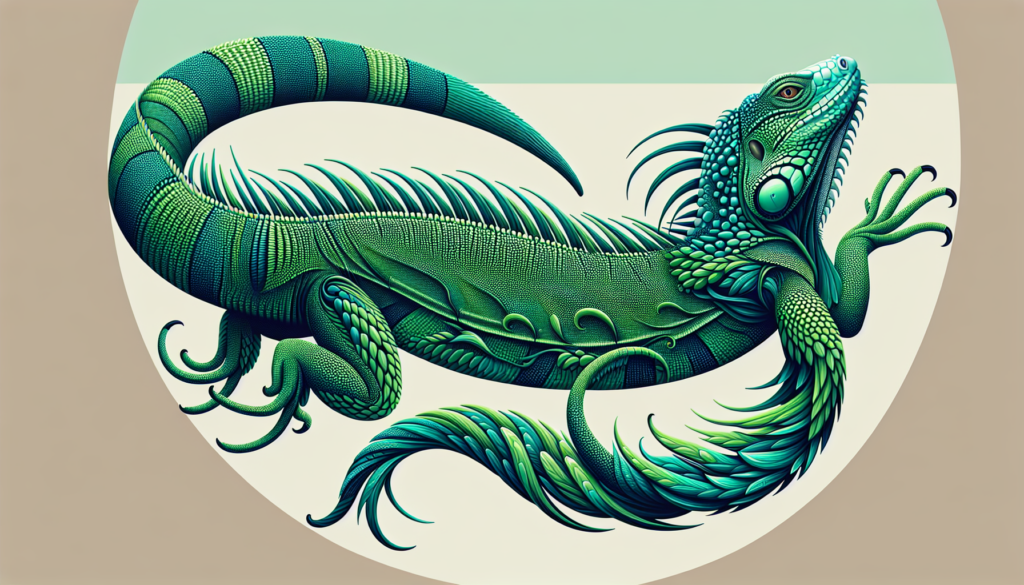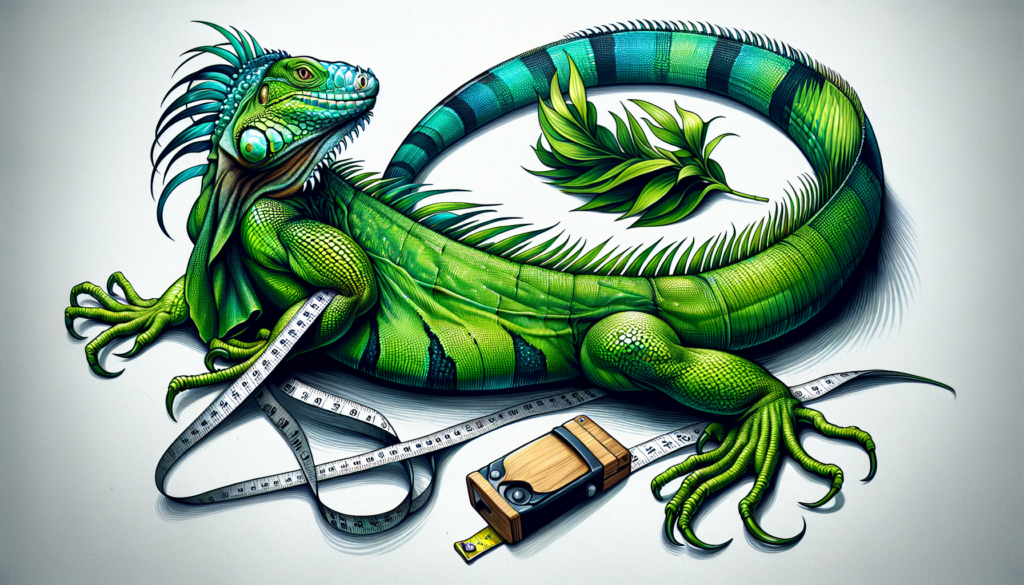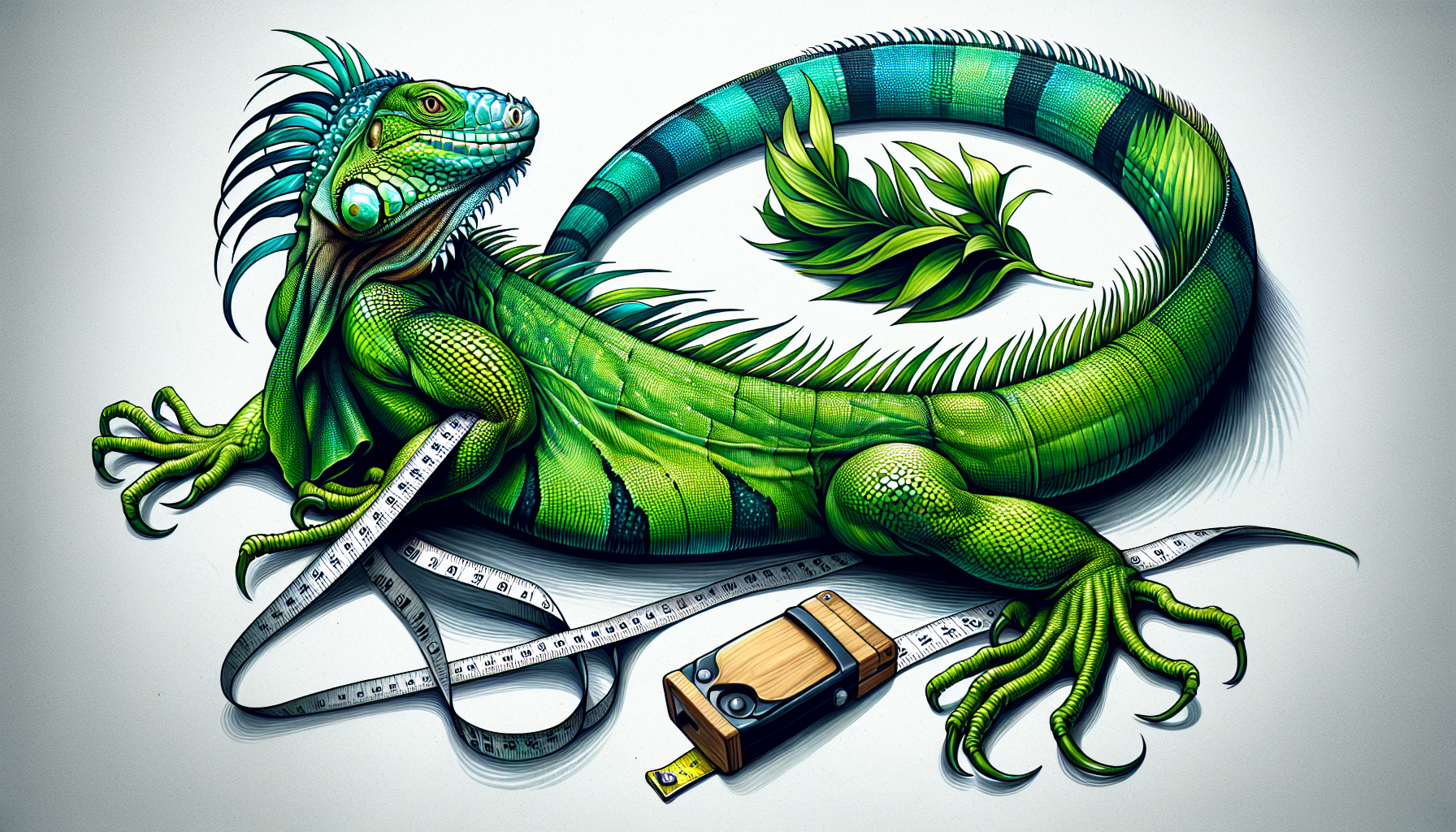Did you know that the green iguana, also known as the common iguana, comes in varying lengths? These fascinating reptiles are known for their vibrant green color and can grow to impressive sizes. In this article, we will explore the average length of a green iguana and uncover some interesting facts about these intriguing creatures. Whether you’re a reptile enthusiast or simply curious about the world around you, get ready to learn more about the incredible sizes these iguanas can reach.

Overview
Green iguanas (Iguana iguana) are fascinating reptiles known for their impressive size. In this article, we will explore the factors that affect the length of green iguanas, including genetics, environment, and diet. We will also examine the average size of green iguanas at different stages of life, compare their size to other iguana species, discuss sexual dimorphism, variation and regional differences, growth patterns and rate, conservation implications, and methods for measuring iguana length. By the end of this article, you will have a comprehensive understanding of the factors influencing the length of green iguanas.
Species Description
Green iguanas are a species of large, herbivorous lizard found throughout Central and South America. They have a distinct appearance, with a slender, elongated body, long tail, and a row of spines running down their back. Their prominent dewlap, or throat fan, is often brightly colored in males and plays a role in territorial displays. Adult green iguanas can reach an impressive length, making them one of the largest lizard species in the world.
Physical Characteristics
Green iguanas possess several physical characteristics that contribute to their remarkable size. Their body is covered in tough, scaly skin, which provides protection from predators and environmental factors. Their tail is muscular and long, comprising a significant portion of their overall length. Green iguanas also have strong, sharp claws that allow them to climb trees and other vegetation with ease. Additionally, their powerful jaw muscles and serrated teeth enable them to efficiently consume the vegetation that makes up their diet.
Factors Affecting Length
The length of a green iguana can be influenced by various factors, including genetics, environment, and diet.
Genetics
Like humans and many other animals, green iguanas have genetic factors that contribute to their overall size. These genetic factors determine the potential size a green iguana can reach, and individuals can vary within this range depending on other environmental factors.
Environment
The environment in which a green iguana lives can have a significant impact on its length. Green iguanas living in areas with abundant resources, such as food and water, are more likely to reach their full potential size. Conversely, iguanas in areas with limited resources may experience stunted growth.
Diet
diet plays a crucial role in determining the length of green iguanas. These reptiles are herbivores, primarily feeding on leaves, fruits, and flowers. A nutritious and diverse diet consisting of a variety of plants can contribute to optimal growth and development in iguanas. On the other hand, a poor diet lacking essential nutrients can result in stunted growth and overall reduced size.

Average Size by Age
Green iguanas go through different stages of life, and their size varies accordingly.
Hatchlings
Hatchling green iguanas are incredibly small compared to adults, measuring around 8 to 10 inches (20 to 25 cm) in length. These tiny creatures are highly vulnerable and rely on their surroundings for protection and sustenance.
Juveniles
As green iguanas enter the juvenile stage, their growth rate accelerates. Juvenile iguanas typically measure between 12 to 18 inches (30 to 45 cm) in length. During this stage, they start developing their distinctive physical characteristics and become more independent.
Adults
Once green iguanas reach adulthood, their size significantly increases. Adult green iguanas can measure anywhere from 4 to 6 feet (1.2 to 1.8 meters) in length, with some exceptionally large individuals reaching lengths of up to 7 feet (2.1 meters). These majestic creatures are a testament to the potential size green iguanas can achieve under favorable conditions.
Size Comparison with Other Iguanas
Green iguanas can be compared in size with other iguana species, such as the marine iguana and the rhino iguana.
Green Iguana vs. Marine Iguana
Compared to the marine iguana (Amblyrhynchus cristatus), which is endemic to the Galapagos Islands, green iguanas are generally larger. While marine iguanas are known for their unique ability to forage underwater and have adapted to a marine lifestyle, they are smaller in size, with adult males averaging around 4.6 to 5.7 feet (1.4 to 1.7 meters) in length. Green iguanas, on the other hand, can reach lengths exceeding 6 feet (1.8 meters) in their adult stage.
Green Iguana vs. Rhino Iguana
The rhino iguana (Cyclura cornuta) is another species that often draws comparisons to the green iguana in terms of size. Rhino iguanas are significantly bulkier and can reach lengths of 4.5 to 5.5 feet (1.4 to 1.7 meters) in adulthood. Although green iguanas are generally longer, rhino iguanas possess a distinctive appearance with a bony casque on their head that gives them their name.
Sexual Dimorphism
Green iguanas exhibit sexual dimorphism, meaning there are noticeable differences between males and females.
Males
Male green iguanas tend to be larger than females, both in terms of body size and overall length. They can reach lengths exceeding 6 feet (1.8 meters) and have more muscular bodies. Males also possess more prominent dewlaps, larger femoral pores, and a row of dorsal spines running down their back.
Females
Females, although smaller in size, make up for it by being slightly more robust. While their average length is around 5 to 6 feet (1.5 to 1.8 meters), females have a slightly wider body structure, an adaptation for carrying eggs during reproduction. Unlike males, females have smaller dewlaps and lack the enlarged femoral pores.
Variation and Regional Differences
Green iguanas can exhibit variability in size and appearance across different geographical regions and habitats.
Geographic Variants
Within the green iguana species, there are recognized geographical variants that exhibit slight differences in size and coloration. For example, iguanas from the Caribbean coast of Central America tend to be larger, while those from Pacific islands such as Baja California are generally smaller. These variations can be attributed to different environmental conditions and resource availability in each region.
Habitat Influences
The habitat in which green iguanas reside can also contribute to regional differences in size. Iguanas inhabiting dense forests with plentiful food sources may grow larger compared to those in more arid regions with limited resources. Additionally, factors such as temperature and humidity levels can influence growth rates and overall size.
Growth Patterns and Rate
The growth of green iguanas follows specific patterns and rates throughout their life cycle.
Early Growth
During the early stages of their life, green iguanas experience rapid growth. Hatchlings grow quickly, increasing in length from a few inches to about 10 inches (25 cm) within the first few months. This accelerated growth is essential for their survival and development.
Growth Plateau
As green iguanas transition from the hatchling stage to the juvenile stage, their growth rate begins to slow down. Growth plateaus occur during this stage, where the iguanas primarily focus on developing their physical characteristics and achieving sexual maturity.
Growth Rate
The growth rate of green iguanas varies depending on various factors, including genetics, environment, and diet. On average, green iguanas can grow around 1 to 1.5 inches (2.5 to 3.8 cm) per month during their early growth stages. However, as they reach adulthood, their growth rate tapers off until it eventually stops.
Conservation Implications
Understanding the size of green iguanas and the factors that influence it has important implications for their conservation.
Size as a Conservation Metric
The size of green iguanas can serve as a valuable conservation metric, especially when assessing the health and well-being of populations. Large and robust individuals are often indicative of favorable environmental conditions and sustainable resource availability. Monitoring the size of green iguanas can help identify potential threats and guide conservation efforts.
Habitat Preservation
Preserving and protecting the habitats of green iguanas is critical for ensuring their continued growth and survival. By conserving forests, wetlands, and other natural areas, we can provide the essential resources and suitable conditions necessary for green iguanas to reach their genetic potential in terms of size.
Measuring Iguana Length
Measuring the length of green iguanas is crucial for various research and conservation purposes. Several standard methods are commonly used.
Standard Methods
Researchers and scientists typically measure iguana length using measuring tapes or rulers. The lizard is carefully restrained, and the tape or ruler is placed along its body, starting from the tip of its snout to the end of its tail. This precise measurement allows for accurate comparisons between individuals and populations.
Challenges and Alternatives
Measuring the length of green iguanas can present challenges, especially when dealing with large and potentially aggressive individuals. In such cases, researchers may use alternative methods, such as estimating size based on photographs or using specialized imaging techniques like photogrammetry. These methods provide valuable data without directly handling the iguanas, ensuring their safety and minimizing stress.
